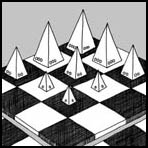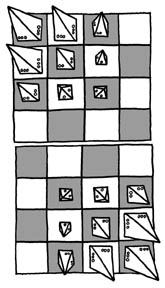 Now you can
play Martian Chess on your iPhone!
The programming was done by Neon Surge, and if you've got an
iPad, you can play the 4 player version!
Now you can
play Martian Chess on your iPhone!
The programming was done by Neon Surge, and if you've got an
iPad, you can play the 4 player version! Now you can
play Martian Chess on your iPhone!
The programming was done by Neon Surge, and if you've got an
iPad, you can play the 4 player version! Now you can
play Martian Chess on your iPhone!
The programming was done by Neon Surge, and if you've got an
iPad, you can play the 4 player version! |
 MARTIAN
CHESS
MARTIAN
CHESSan Icehouse game by Andrew Looney
Martian Chess is a chess-like strategy game in which location, rather than piece color, determines which pieces you may move. Like Chess, each type of piece has its own way of moving, and you capture by moving onto an opponent's square; but unlike Chess, you can only move pieces sitting in your own quadrant, and only attack those in other quadrants which may include your own former pieces. The game ends when someone runs out of pieces, and the winner is the player who captured the most points.
Each player starts by setting up nine Icehouse pieces, three of each size, in their own corner of the board, as shown. Since piece color is of no significance in this game, each player should select a variety of colors to start out with, in order to make it easier to disregard the color of the pyramids.
Queens: The large pieces may move in any direction, straight or diagonally, as far as you like (without jumping over any pieces), just like a Queen in regular chess.
Drones: The medium pieces move only on straight paths (never diagonally) one or two spaces at a time, like a Rook in regular chess, but with a limited range.
Pawns: The small pieces move one space at a time, in any direction, along the diagonal like a cross between a Bishop and a Pawn in regular chess.
To play Martian Chess, you need to imagine a pair of perpendicular dividing lines which split the board into fourths. These dividing lines are called Canals. During the game, each player will have complete control of one of the 4 zones separated by canals.
Color is meaningless in Martian Chess. The way you know which pieces you control is determined instead by the location of the pieces at any given moment.
Any piece located in your zone of the board is yours only you may move it. The upshot of this is that anytime you move a piece across a canal, it changes ownership and becomes one of your opponent's pieces. When you move a piece from one place to another within your own territory, of course, the piece remains yours.
An enemy piece is captured by moving your piece onto its square, just as in normal chess. This means that whenever you capture, you give control of your piece to the opponent whose piece you took.
The player whose hair color is closest to red shall go first.
If you no longer control any Queens, you can move a Drone into the same space as a Pawn (or vice versa), remove both pieces from the board, and replace them with a Queen. (Or you can just stack one piece on top of the other.) Similarly, if you have no Drones, you can create a new one by merging two Pawns.
The game ends as soon as one player runs out of pieces, i.e. as soon as one quadrant of the board is completely empty. Note that a player with only one piece remaining can force the end of the game by moving that piece across a canal.
The player with the highest score wins. Points are awarded as follows for all captured pieces, regardless of color:
Queen: 3 points
Drone: 2 points
Pawn: 1 point
For this alternate version of the game, the two players facing each other diagonally across the board will be considered a team. Play is then conducted as usual, except that at the end of the game, the pair of players with the highest combined score wins.
 RULES
FOR TWO-PLAYER GAMES
RULES
FOR TWO-PLAYER GAMESIf you are playing with only two players, then you will only use half of the regular chessboard. The other half should, if possible, be folded out of sight. The pieces are then set up in opposing corners as shown:
No Rejections: Additionally, in a two-player game, a player may not "reject" the move of the opponent. If a player moves a piece across the canal, the opponent cannot simply move it back to its original square.
Example: If John moves a Queen from square A (in his zone) to square B (in Lisa's zone), Lisa can't just move it back to square A. She can move it to any other square, but she can't simply "reject" John's move. Lisa can move it back to square A later on, because the rule only applies to a pair of sequential moves.
Beware the Double Whammy: Whenever you capture a piece, make sure the piece you used for capturing isn't in a position where it can immediately capture one of your own remaining pieces (unless you're happy enough making an exchange...).
Remember the Bottom Line: Keep in mind that the goal is points, not position (i.e. there is no checkmate). This is particularly vital in a 4 player game, when 2 people can use the Double Whammy on each other to quickly trade pieces for points.
Run For The Border: If you're ahead on points and low
on pieces, try to end the game quickly by pushing your last few
pieces across a canal.